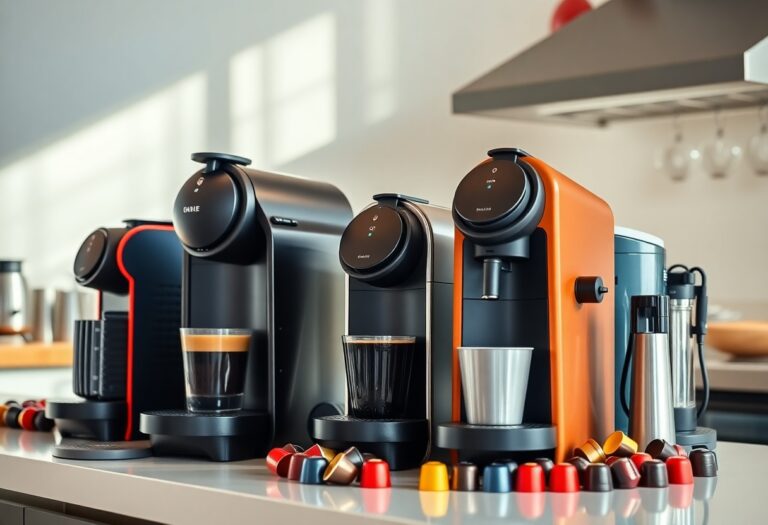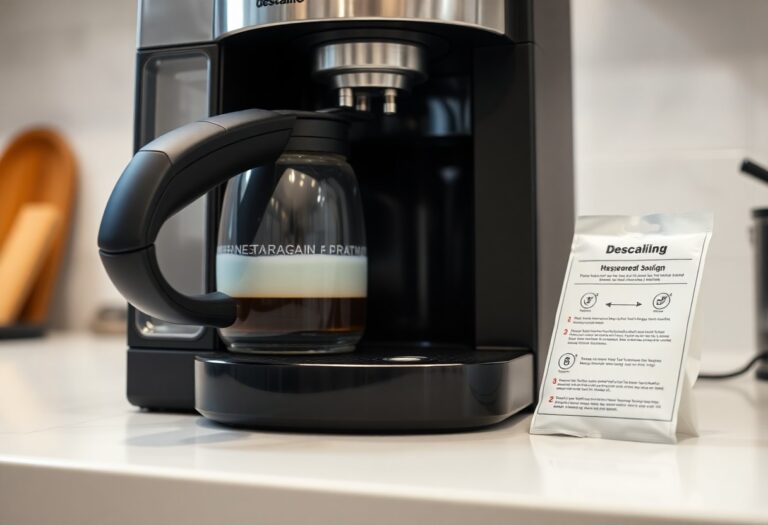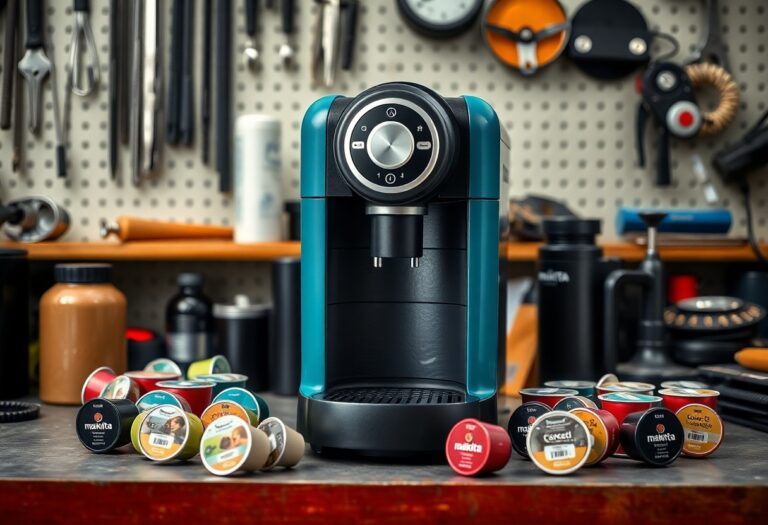What Pressure Should a Coffee Machine Be – Optimal Settings
You might be surprised to learn that the pressure at which your coffee machine operates can significantly affect the taste of your brew. For the best results, your espresso machine should generally be set to around 9 bars of pressure, as this range helps extract the rich flavors and aromas you’ll enjoy in every cup. Using too much pressure can lead to bitterness, while too little results in a weak brew. To dive deeper into the optimal settings, check out this resource on how many bars of pressure for the perfect coffee and more!
Key Takeaways:
- The optimal pressure for brewing coffee in a machine is typically around 9 bars.
- Higher pressures can lead to over-extraction, resulting in a bitter flavor profile.
- Lower pressures may cause under-extraction, yielding a sour taste in the coffee.
- Monitoring pressure during the brewing process can help maintain consistency in flavor and quality.
- Understanding the specific coffee machine and its design is important, as some machines may have unique pressure requirements.
The Mechanics of Coffee Pressure
Understanding coffee pressure involves delving into the physics of brewing. When brewing espresso, the machine generates considerable pressure—normally between 9 to 15 bars. This is achieved through a pump mechanism that forces water through the coffee grounds. Each bar of pressure translates to approximately 14.5 psi, affecting the speed and efficiency of extraction, allowing you to achieve that rich, aromatic cup you crave. The precise control of this pressure helps to optimize flavor extraction and maintain consistency in every brew.
Exploring the Role of Pressure in Extraction
Pressure plays a defining role in coffee extraction. As hot water is forced through compacted coffee grounds, the pressure enables the extraction of oils, flavors, and other soluble compounds. Lower pressure results in a weaker and under-extracted brew, while excessively high pressure may lead to bitterness, as over-extraction saturates the grounds too aggressively. Finding the right balance helps you unlock the full potential of the coffee’s flavor profile.
How Pressure Affects Flavor Profiles
The relationship between pressure and flavor in your cup of coffee is complex and fascinating. With higher pressure, certain flavor compounds, like fruity and floral notes, become more pronounced. Conversely, lower pressure can yield a milder, softer taste, often lacking brightness. Dialing in the right pressure not only enhances desirable flavors but also creates a well-rounded cup that showcases the unique characteristics of your selected beans.
For instance, when brewing espresso at 9 bars, you’re likely to extract sugars and acids more effectively, resulting in a vibrant acidity and sweet profile. Increasing to 15 bars may intensify heavier, bitter notes while reducing the complexity you’ll desire from lighter roasts. As you experiment with your coffee machine’s pressure settings, consider the origins and roast types of your beans. Understanding how different pressures affect your beverages can guide you in crafting the perfect cup to suit your taste preferences.

Ideal Pressure Settings for Different Brewing Methods
Understanding the ideal pressure settings for various brewing methods greatly enhances your coffee experience. Each method requires fine-tuning your pressure to extract the best flavor profiles and achieve a fantastic cup. Here’s a breakdown of what you should aim for with each technique.
Espresso Machines: The Golden 9 Bars
For espresso machines, hitting a consistent pressure of 9 bars is imperative. This pressure optimally extracts rich oils, acidity, and sweetness from coffee grounds, delivering a well-balanced shot with a velvety crema. Deviating too far from this benchmark can lead to over-extraction or under-extraction, resulting in bitter or sour flavors in your espresso.
French Press and Aeropress: Variability in Pressure
With French press and Aeropress methods, pressure settings can vary significantly. Unlike espresso machines, these brewing techniques depend on your personal taste preferences and desired strength of the coffee. You can experiment with lower pressures for a smoother flavor or maintain higher pressure for a bolder profile, making each brew unique.
In the case of the French Press, the steeping time heavily influences the final taste. While you’ll exert pressure during the plunge, it’s more about the duration and technique rather than a specific PSI. The Aeropress, on the other hand, allows a bit more control with varying brewing styles, from high-pressure techniques that yield espresso-like shots to gentler methods for a mellow brew. The versatility in pressure application grants you the liberty to tailor each cup according to your liking, unlocking a spectrum of flavors waiting to be experienced.
The Impact of Pressure on Coffee Grind Size and Quality
Altering the pressure during coffee brewing can significantly influence grind size and the overall flavor profile of your cup. Higher pressures usually necessitate a finer grind, which enhances extraction by providing greater surface area for water to interact with coffee grounds. On the flip side, using lower pressure may require a coarser grind to avoid over-extraction, potentially leading to a bitter taste. To achieve the perfect balance, understanding how pressure and grind size interrelate is vital for perfecting your coffee experience.
Understanding Grind Size and Its Relationship to Pressure
Grind size directly affects the rate of extraction during brewing; finer grinds expose more surface area to water, typically performing best at higher pressures. Conversely, coarser grinds reduce surface area, allowing for adjustments in brewing pressure to prevent bitterness. By fine-tuning grind size and pressure together, you can manipulate flavor nuances and achieve a balanced cup.
Experimenting with Pressure to Achieve Desired Results
To refine your brewing technique, experimenting with pressure settings can lead to remarkable improvements in taste. Try varying pressure in small increments while observing how it influences the extraction and flavor profile of your coffee. A slight increase in pressure can draw out more oils and fragrances, leading to a richer, more full-bodied espresso.
For instance, starting with a traditional brewing pressure of around 9 bars, you can adjust up or down in small increments while maintaining the same grind size. When you increase the pressure to 10 or 11 bars, watch for changes in taste and extraction time. A pressure increase may produce a richer crema and fuller flavors, while reducing it may highlight acidity and brightness. Document your findings in a brewing journal to replicate successful experiments in the future, ensuring you develop a customized brewing routine tailored to your individual palate.

Common Misconceptions About Coffee Pressures
Many coffee enthusiasts harbor misconceptions about the role of pressure, assuming that higher pressure always translates to a superior cup of coffee. This notion perpetuates myths that can mislead you during the brewing process, suggesting that simply ramping up the pressure settings will enhance flavor and aroma. Understanding these challenges is imperative for brewing your best cup.
Debunking Myths: Higher Pressure Equals Better Coffee?
The belief that higher pressure results in better coffee lacks support from experienced baristas and coffee scientists alike. While high pressure can extract flavors more quickly, it may also result in over-extraction, yielding bitter, unpleasant notes. The art of coffee brewing lies in balancing pressure with other variables, such as grind size and water temperature, to achieve your desired flavor profile.
The Importance of Consistency Over Maximum Pressure
Focusing too heavily on maximizing pressure can distract you from what truly matters: achieving a consistent brew. Consistency in pressure helps develop a balanced extraction of flavors, leading to a more enjoyable cup. For instance, espresso machines typically operate between 8-10 bars of pressure for optimal results, allowing for repeatable success while avoiding the faults of over-extraction.
In practice, aiming for consistency means that every cup of coffee brewed under the same conditions will yield similar results, which is key to perfecting your coffee. If you’re fluctuating between vastly different pressure levels, the flavor profile will vary wildly and can confuse your palate. For example, when using an espresso machine set at a stable 9 bars, the extraction process will remain fluid and predictable; this ultimately paves the way for mastering the brew and developing a better understanding of your coffee’s subtle flavors. Prioritize stability over raw power, and you’ll achieve a superior coffee experience.
Adjusting Your Machine: Practical Steps for Optimal Pressure
To achieve the perfect coffee extraction, fine-tuning your machine’s pressure settings is a must. Start by consulting your manual to locate the pressure adjustment knob, typically found near the pump. Many machines allow for pressure adjustments in increments of 1-2 bars, so small changes can lead to significant improvements. After adjusting, test your coffee and be mindful of both the flavor and texture; a balanced extraction will result in a rich crema and pleasant aroma. Keep track of your adjustments to determine what works best for your taste.
Calibration Techniques for Home Baristas
Calibrating your coffee machine involves setting the pressure to match the type of coffee you use. Start with a baseline pressure, usually around 9 bars, and experiment by adjusting it up or down based on your grind size and extraction time. Use a scale to measure the coffee and water accurately to ensure consistency. Consistent results rely on measuring not only the pressure but also the dose and yield of each shot, which helps build a tailored approach for your preferred brew.
Troubleshooting Pressure Issues in Coffee Machines
If your coffee machine is not achieving optimal pressure, several factors could be at play. Start by inspecting the pump, as worn-out components can lead to lower pressure. Clogged filters and scale build-up in the water lines also contribute to pressure inconsistencies. Regular maintenance, such as descaling and cleaning, can help maintain your machine’s performance and longevity. If the problem persists, consulting a professional technician might be necessary.
Addressing pressure issues involves a systematic approach. First, check for any obstructions or clogs in the coffee grounds, which can restrict water flow. If you’re using an older machine, worn seals or gaskets may also prevent the required pressure from building. It’s advisable to regularly clean your machine and replace any worn parts. Additionally, you might want to assess the quality of your water, as hard water can lead to mineral deposits that hinder optimal performance. Troubleshooting these elements can significantly improve your coffee extraction consistency and overall taste.
Final Words
So, understanding the importance of pressure settings in your coffee machine enables you to craft the perfect cup. The optimal pressure typically ranges between 9, 15, and 19 bars, depending on your brewing preferences and equipment. By adjusting your machine accordingly, you’ll enhance the richness and flavor of your coffee. For a deeper insight into pressure settings, check out this resource on the 9, 15 or 19 bar – what is the ideal pressure in a coffee machine.
FAQ
Q: What is the ideal pressure for espresso extraction?
A: The ideal pressure for espresso extraction is typically around 9 bars (130 psi). This pressure is sufficient to extract the rich flavors and oils from the coffee grounds while creating a nice crema on top of the espresso. Some machines may operate slightly above or below this pressure, but aiming for the 9-bar mark is generally recommended for optimal results.
Q: How can I adjust the pressure on my coffee machine?
A: Adjusting the pressure on a coffee machine often depends on the specific model you own. Some machines come with built-in pressure gauges and adjustment controls, allowing you to set the pressure manually. Others may require you to modify the pump settings or use different coffee grind sizes and tamping techniques to influence the pressure indirectly. Check your machine’s user manual for specific instructions or consult online forums for tips tailored to your model.
Q: What happens if my coffee machine’s pressure is too low?
A: If the pressure is too low, the extraction process may result in under-extracted coffee. This means the coffee can taste weak, watery, and lacking in flavor. Additionally, a lower pressure may not create sufficient crema, which is an important feature of a well-brewed espresso. It’s crucial to ensure that your machine maintains the right pressure to achieve a rich and balanced cup of coffee.
Q: Is higher pressure always better for brewing coffee?
A: Not necessarily. While higher pressures can intensify flavors, an excessively high pressure can lead to over-extraction, resulting in bitter and unpleasant tastes. The key is to find the sweet spot—generally around 9 bars—where the extraction process is balanced, producing a well-rounded flavor profile without the undesirable bitterness.
Q: How does the type of coffee bean affect the pressure settings?
A: The type of coffee bean can influence the optimal pressure settings for extraction. Different beans have unique flavor profiles and density levels. For example, lighter roasts may require slightly different brewing parameters compared to darker roasts. Adjusting the pressure may help to highlight the flavors in the coffee, but it is usually recommended to start with the standard 9-bar setting and adjust based on personal taste preferences and the specific characteristics of the beans used.







